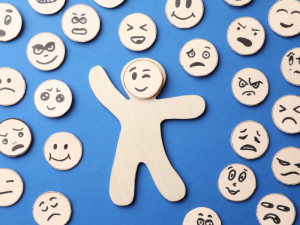Physical pain is essential to the human experience; it’s the body’s protective alarm system. It’s a subjective experience that is challenging to convey to others. Especially if there are no obvious outward clues, our ability to tolerate pain is as individual as our fingerprints and shaped by many factors: genetics, previous pain experiences and our beliefs. Lifestyle and social environment also have a role to play; the quality of our sleep and our general and psychological health can impact our pain levels.
When we get “hurt”, as some of my patients, young and older, like to call their injuries, a whole cascade of things happens: the ‘sensation’ is sent swiftly from the affected body part to the brain, signalling the OUCH! Fortunately, most of these are temporary unpleasant experiences. In most cases, for example, you stub your toe, and the tissue around the wound will feel tender and sore while it heals, but we respond individually to the same stimuli; some people can brush an injury and get on with their day, while others react more severely, sometimes seemingly disproportionately.

Gaining a better understanding of how and why we individually respond to pain is crucial because it [pain] blights people’s lives, affects their relationships, and overwhelms the NHS and allied health care professionals. New studies have begun to explain why we react differently to pain. Please think of the brain as a simple control centre, making swift predictions on the severity of an injury or trauma and then creating super-speedy estimates of how painful it should be.
Sometimes this process goes haywire, and the brain mistakenly continues to fire out pain signals long after the damaged tissues have mended. Or when there is no threat, leading people into persistent or chronic pain. It isn’t possible to predict who will slip into these states, but studies show it is more likely to occur during periods of high pressure, prolonged stress or sadness.

Medicine and sciences categorise pain into distinct phases, which I have described in a previous post (pain, what’s going on). In the UK, persistent or chronic pain affects one in five adults; this is huge. It can affect any part of the body and all age groups. According to pain medicine experts, chronic pain changes how the spinal cord, nerves, and brain process potentially unpleasant stimuli. These tissues become overreactive or hypersensitive for reasons not fully understood.
However, we still have some control. In that, the brain and our emotions can dial down or turn up our pain experience. This insight is not insignificant but a challenging concept for those affected; this is what we know:
- Our pain threshold, also called tolerance of pain, is influenced by previous traumatic experiences.
- People with anxiety or depressive conditions appear more susceptible to physical pain and report it higher.
- Smokers report pain more often and at high levels too.
- Those with a BMI of over 30 also appear to experience more pain.
- Interestingly, apart from professional footballers, most athletes have a higher pain tolerance than the general population.
Our adult response to pain is largely determined by our childhood learning encounters with injury and pain. Consider this example:
-
-
- A toddler has a little tumble in the playground; he picks himself up and plays despite his grazed knee.
- The same child trips in the clear view of his primary caregiver, who rushes, yelling to his aid. While this is not a conscious decision, his behaviour is ultimately shaped by the caregiver’s (over) reaction. So he learns to ‘react’ to be rewarded; by displaying distress and experiencing more pain. Further, studies show that this can become a learnt behavioural response to pain and predispose people to chronic pain as adults.
-

While we cannot change our genes or early socialisation, we can influence how our brains perceive pain as adults. Don’t you believe me? Let’s go back to when painkillers became readily available; it was common for people to use various mind-body techniques to regulate their response to pain, distraction being the most familiar. Mindfulness and self-hypnosis are popular and effective ways to ramp up our pain tolerance and dial down discomfort and other unpleasant sensations in this century. Movement practices and exercise are other good options because they help release natural painkillers called endorphins.
Let’s pop back to the tumbling toddler if I could step in. I would encourage his primary caregiver to respond differently. To wait quietly and calmly and check to see he wasn’t too badly hurt, reassuring him if needed and sending him back to play; the perfect pain distraction. This approach will prime his brain to be more resilient and build healthier injury experiences.
Why is chronic pain still such a mystery?
After decades of studies and PhD-level research, chronic pain is still a mystery. We know that pain can be complex and complicated, caused by many factors and conditions. The reality is that it’s still an impossible dilemma because up to 50% of all consultations in primary care are folk with medically unexplained symptoms (MUS). A mammoth-sized challenge for any healthcare system. We don’t know what we’re looking at, so how do we best treat it? – It’s a rhetorical question.
Final thoughts. Is this hopeless?
I think not; because this is what we do know.
- Persistent pain is often associated with subconsciously unhelpful behaviours and habits, such as breath-holding or rapid shallow breathing, which also triggers the flight-fight-freeze stress response. These strategies can become a neurological habit that further fuels the fear-avoidance and guarded movements often observed in people with chronic pain.
- Movement therapy is a practical and meaningful way to support people to create more beneficial habits. Most (but not all cases) ultimately result in a significant reduction in pain or resolution. Which, with practice, reduces muscular tension and lowers stress allowing healthier movement and loading patterns. People often ask me how long their recovery will take. Truthfully there is no simple answer; complex and long-standing problems take a while; most people should be willing to commit to 3-12 months or regular sessions with a practitioner if they can. Recovery usually involves navigating and reassessing because it’s rarely a straight line. While this is a challenge of time and expense, the potential gains make the serious negotiation (with oneself), perseverance, courage and outside help worth every minute and every payment card swipe. Everyone has their own pain story, so there can’t be a one size fits all prescription, which is why we don’t have a cure yet.






